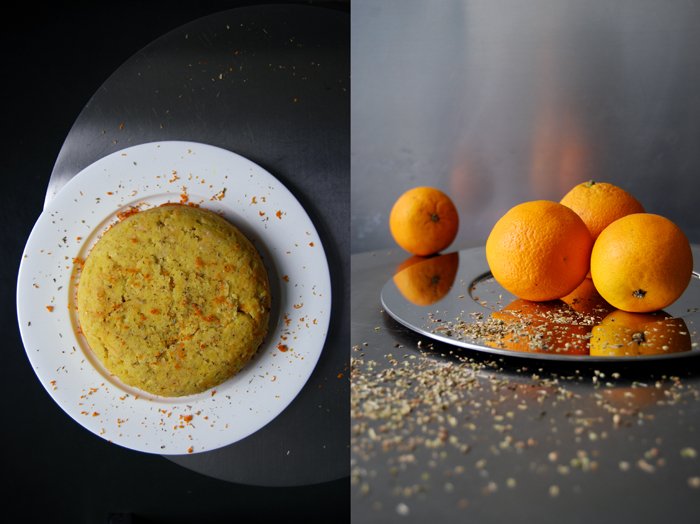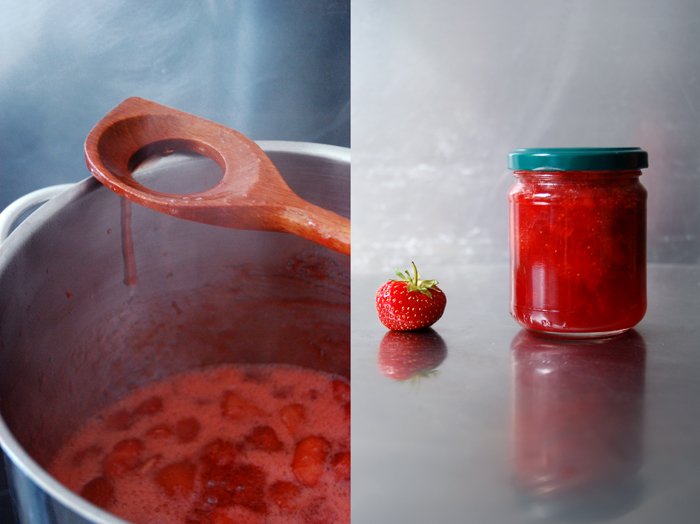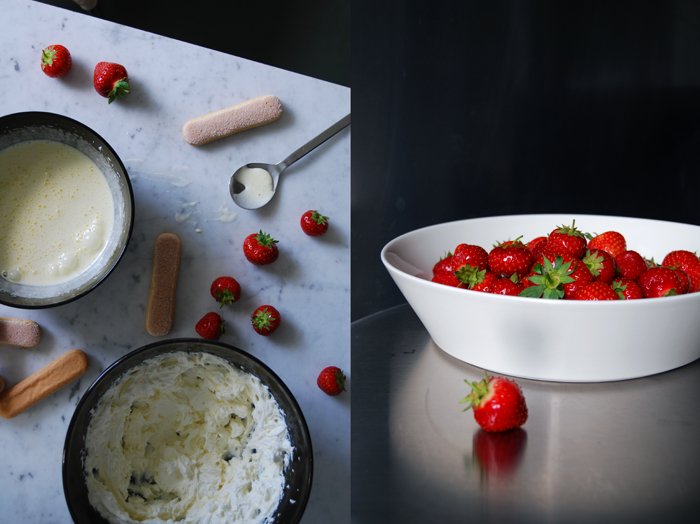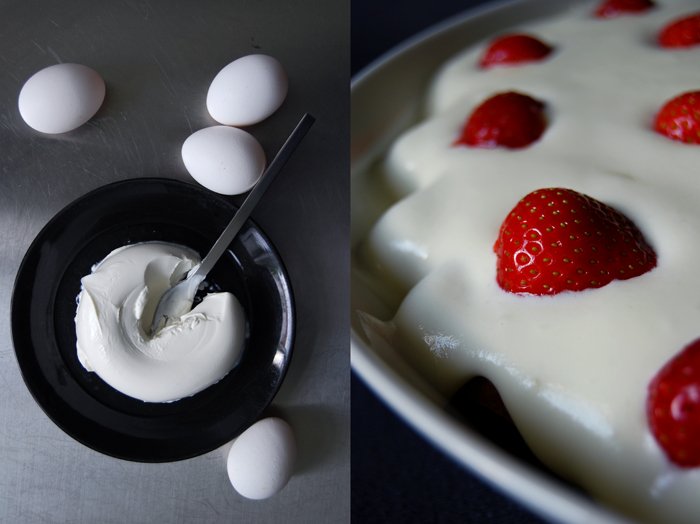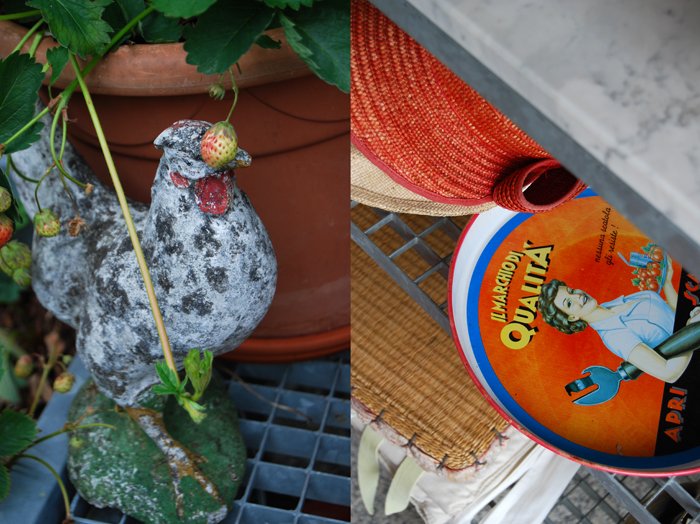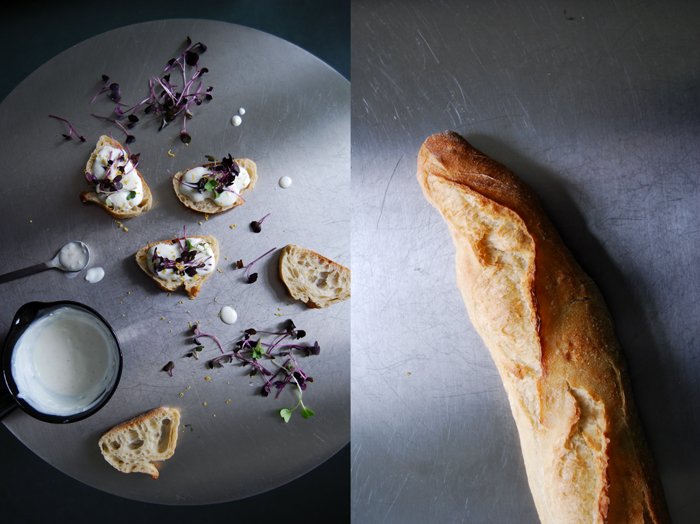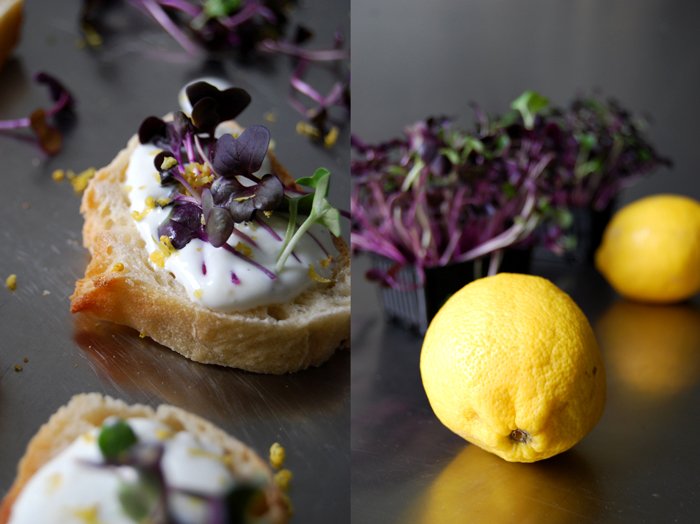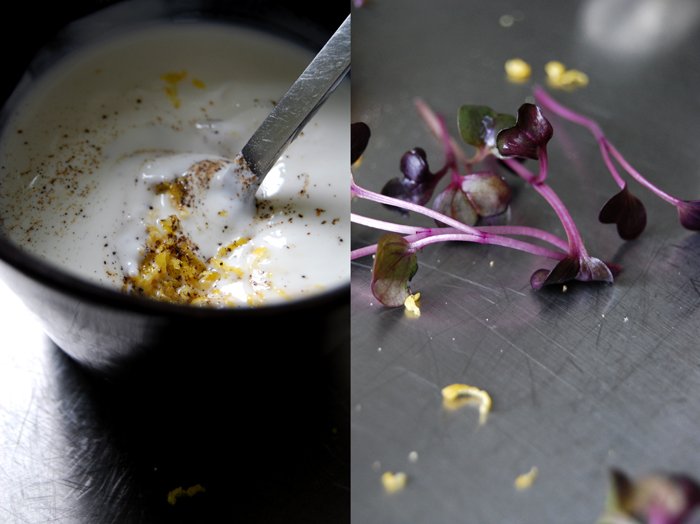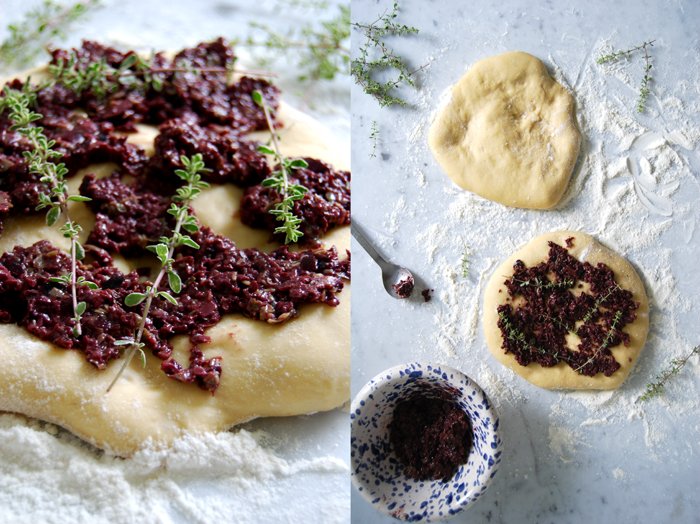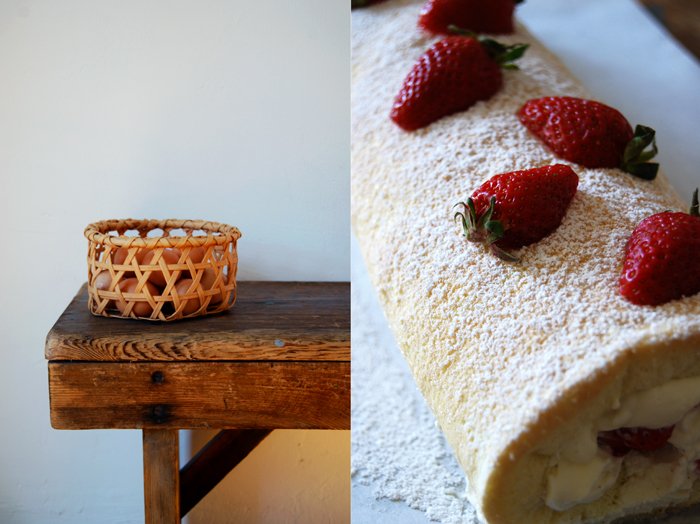Mâche, Avocado and Raspberry Salad with Honey
This week I can't get enough berries! When I see all those boxes filled with tiny colourful berries at the market I don't even know where to start. Raspberries, gooseberries, red currants, strawberries, so much to choose from! Unfortunately, they haven't reached their peak in sweetness yet due to our disastrous summer weather, but I enjoy them nonetheless. I can't wait any longer, we only have them for a few months and I don't want to miss out.
As much as I love to throw these fruits on tarts or enjoy them as a fruity nibbling alternative to chocolate, they are just as good in fresh and crunchy salads. Combined with the slices of a ripe and velvety avocado, they bring some freshness into the mix. Some mâche salad (also known as field salad or lamb's lettuce) mixed in adds some crunchy bite, perfect for those hot days which I'm still hoping for optimistically. I'll be in Malta soon, there I will definitely get my boiling hot summer weather but I won't find my delicate raspberries. Sometimes you can't have everything in life!
For the 2 of us, I spread a handful of lettuce on 2 plates and covered each of them with the slices of a quarter of a soft avocado and 8 raspberries. I wanted to keep the dressing sweet and fruity, you can use either Balsamico vinegar or raspberry vinegar (or mix the two of them). Whisk 3 tablespoons of olive oil with 2 tablespoons of vinegar, add 1/2 a teaspoon of honey and season with salt and pepper. Sprinkle over your salad sparingly.
Roasted Apricots on Turmeric Bread
Sandwich Wednesday news! After 7 months of baking my own bread or visiting one of my trusted bakeries, there will be a new monthly sandwich feature on the blog, eat in my kitchen x The Bread Exchange.
The Bread Exchange is a trading project started by Malin Elmlid in 2008, she is a master when it comes to baking the perfect sourdough bread. Together we will share our creations on eat in my kitchen, every month she will deliver a loaf of bread to my kitchen and I will turn it into a new sandwich idea. This will be exciting as Malin likes to use the exotic ingredients she gets through trading; turmeric from Iran, vanilla from Madagascar, salt from Israel, charcoal, matcha, the list is long and inspiring!
You can't buy Malin's bread, you can only trade for it and that makes it all the more special. You can offer culinary products, a dinner, invite her to a special place, teach her one of your skills or share a talent. Anything of personal value might inspire her and become your trade. The Bread Exchange has been going on all over the world, wherever Malin goes, her sourdough travels with her. More than 1400 loaves of bread have been traded and thankfully enjoyed in Berlin (where she lives), in Sweden (where she's from), the Netherlands, Afghanistan, Sinai, Morocco, Greece, USA and Belgium.
Last winter Malin asked me if I would like to test cook a couple of the recipes for her first cookbook which will be published this autumn. I cooked, baked and savored, they were all delicious and worked out perfectly - it will be so exciting to have the final The Bread Exchange book in my hands!
Now it's time to talk about sandwiches! Malin suggested starting off with her Moonraker Sourdough, a turmeric and honey bread which she created a couple years ago. It's originally made with dried apricots but she left them out this time. This glowing yellow loaf of bread with a strong spice aroma is inspired by the colour palette of the famous 70's Bond movie which gave it its name. Look at the colour and texture of this beautiful bread, imagine turmeric and the best sourdough bread you've ever eaten and you will have an idea of what I had on my kitchen table! As most of you won't be able to find a turmeric bread I will involve the flavours that Malin uses in her bread creations for my sandwiches, so you just have to get (or bake) the best sourdough bread you can find in town and then you can start!
Here's our first eat in my kitchen x The Bread Exchange sandwich creation, fresh apricots roasted with thyme, cardamom and turmeric in honey olive oil together with maple syrup and cardamom crème fraîche on thick slices of turmeric sourdough bread! This sandwich is wonderfully aromatic, juicy and fruity, the spices are present but not overpowering. If you don't have a loaf of bread at hand you could also pack the roast fruits on vanilla ice, this is just as good!
My next sandwich cooperation with Malin will be in August, I don't know what she'll bring to my kitchen but I can't wait to enjoy another one of her creations!
Roast Cardamom Apricots on Turmeric Bread
For 4 open sandwiches you need
sourdough bread, 1 loaf, cut into thick slices
fresh apricots, cut in half, 6
honey 1 tablespoon
olive oil 1 tablespoon
ground turmeric 1/4 teaspoon
ground cardamom 1/4 teaspoon
thyme 10 small sprigs
coarse sea salt
For the spread
crème fraîche or cream cheese 150g / 5.5 ounces
maple syrup 1 teaspoon
a pinch of ground cardamom
a pinch of salt
Set the oven to 230°C / 450°F.
Warm up the honey in a sauce pan and whisk in the olive oil, turmeric and cardamom. Coat the apricots with the honey olive oil, sprinkle with sea salt and spread on a baking dish (cut side up). Lay the thyme on top and roast in the oven for 8 minutes, turn the fruits around and bake for another 2 minutes.
Whisk the ingredients for the spread till creamy, season to taste and spread on the slices of bread. Put 3 apricot halves on each slice, gently as they are soft. Sprinkle with a couple roast thyme sprigs.
Gattò di Patate, Potato Cake with Orange and Oregano
I ate my first gattò di patate a couple years ago in Sicily, a rich potato pie flavoured with Parmesan and herbs. It's a simple dish, as comforting as a nice bowl of pasta savored on the sofa. I liked it so much that I had to try it in my kitchen when I was back home. Some fill it with minced meat or Mozzarella but mine is a celebration of my favourite Sicilian ingredients, orange and oregano. I first encountered this aromatic combination together with a little olive oil and sea salt, as a refreshing breakfast salad during a holiday on a picturesque farm in Noto. This duo is so good that I've used it in quite a few dishes since then, always with satisfying results!
This pie is another example of the French influence on Sicilian cooking, the name for the Italian dish gattò di patate comes from the French gateau (meaning cake). When I shared my Sfincione recipe with you a couple weeks ago I mentioned that there was a big French movement in Sicilian kitchens in the beginning of the 18th century, very often evident by the generous use of eggs and butter. Today's pie follows this rule as well, eggs, butter, flour, parmesan and spices turn simple mashed potatoes into a savory cake. You can eat it as a primo piatto, thinly sliced as it's so rich, or as a main on a cosy night.
Gattò di Patate, Potato Cake with Orange and Oregano
For 4-6 people you need
potatoes, peeled, cooked and drained, warm, 600g / 21 ounces
butter 70g / 2.5 ounces
Parmesan, grated, 120g / 4 ounces
organic eggs, 2 large or 3 small eggs
a pinch of nutmeg, freshly grated
salt 1 teaspoon
pepper
dried oregano 1 teaspoon plus 1 teaspoon or more for topping
zest of 1 small orange for topping
Set the oven to 180°C / 355°F and butter a 20cm / 8" baking dish or springform pan.
Press the warm potatoes through a ricer and mix with the butter, cheese, eggs and spices. Put in the baking dish, even it out and bake for 45 minutes until the pie is cooked through and the centre is set. Let the pie cool for 5-10 minutes before you turn it around (or take it out of the springform pan). Sprinkle with oregano and orange zest and serve warm.
A Perfect Raspberry and Blueberry Tart with Bavarian Cream
More than twenty years ago I spent a beautiful two weeks in the South of France together with my uncle's family. We stayed in a pink house in the hills of Grasse surrounded by a blossoming garden full of roses, jasmine and lavender. My room faced this fragrant oasis, a French picture book scene in white, blue, red and pink. I used to sit on my bed with the windows wide open, watching the curtains fly in the warm wind, mesmerized by the scent that caught all my senses. Grasse has been known as the "world's perfume capital" since the end of the 18th century. Thanks to its warm climate it is ideal for flower farming, this is where the best parfumeurs get trained to distinguish between thousands of scents. Although I didn't go there with any professional intentions I'm sure my sense of smell wasn't the same after this holiday!
This leads me to another sense, the sense of taste! My family is very passionate about food and so are my aunt and uncle. We went to amazing restaurants and kept the cooking in the house quite simple but nonetheless delicious. Salads, fruit, pasta but also quail and fish were on our table. One afternoon, we invited some friends to come over for tea and the lady who took care of the house offered to bake a fruit tart. Her creation was one of the prettiest I've ever seen and definitely one of the best I have ever eaten. It was very simple, a perfect short crust base topped with circles of four or five different berries, all sweet and ripened under the French sun. We all loved it!
I'm a big fan of these summer tarts, buttery short crust and fruit is just my kind of combination. This is a cake you can enjoy in the hottest temperatures when heavy cream cakes are already out of the question.
This holiday will always remind me of this wonderful cake and the memories of the smell and the hills of Grasse will always inspire me to bake a tart. Today I gave it a raspberry and blueberry layer on top of a delicious Bavarian cream, fluffy, light and full of vanilla. The pastry is crisp and light but strong enough to carry the cream without getting soggy. This is a perfect tart to me - so good that I always bake two of them straight away!
Raspberry and Blueberry Tart with Bavarian Cream
For 2 tarts in 22cm / 9" tart pans you need
blueberries 200g / 7 ounceras
pberries 100g / 3.5 ounces
For the short crust base
plain flour 400g / 14 ounces (I use white spelt flour type 630 but you can use any other plain flour)
granulated sugar 100g / 3.5 ounces
salt 1/4 teaspoon
butter 200g / 7 ounces
organic egg yolks 3
water 3 tablespoons
Combine the flour with the sugar and salt. Cut the butter with a knife into the flour until there are just little pieces of butter left. Continue with your fingers and work the butter into the flour until combined (there shouldn’t be any lumps of butter left). Add the egg and water and continue mixing with the hooks of your mixer until you have a crumbly mixture. Form 2 discs, wrap in cling film and put in the freezer for 15 minutes.
Set the oven to 200°C / 390°F top/ bottom heat.
Roll out the dough between cling film and line your tart pans with the flat pastry. Prick it with a fork and blind-bake in the hot oven for 20 minutes or until golden. Let the tarts cool completely before you take them out of their pans.
For the Bavarian cream
organic egg 1
organic egg yolks 2
sugar 80g / 3 ounces
a pinch of salt
milk 250ml / 8.5 ounces
vanilla bean, slit slightly, 1/2
gelatin sheets 2
heavy cream, whipped, 230g / 8 ounces
Soak the gelatin sheets in cold water for a few minutes.
Whisk the egg, egg yolks, sugar and salt till thick and fluffy.
In a sauce pan, bring the milk together with the vanilla bean to the boil. Take the vanilla bean out, scrape the seeds out of the bean into the milk. Whisk the egg mixture into the hot milk and put the pan back on a medium heat, stirring constantly. When the cream is thick enough to coat the back of a spoon (it will take around 5 minutes depending on the temperature) take it off the heat.
Squeeze the soaked galatin sheets into the egg mixture and crumble the sheets in. Whisk well, fill in a bowl and let it cool for a few minutes before you put it in the fridge to bring it to room temperature.
Gently fold in the whipped cream and cool in the fridge for 2 hours until the cream is set.
The fruit tart
Divide the Bavarian cream between the 2 tarts and spread evenly. Garnish with the fruits and serve immediately or keep in the fridge.
The crust is best when it's fresh but we still enjoyed a couple pieces after the tart had been in the fridge.
Spinach, Strawberry and Goat Cheese Salad with Pink Peppercorns
Green, white and red! Many of my summer dishes sing praise to the Italian flag, without any intention, but maybe my subconscious has something to do with it as I love this country so much. I was so shocked and sad for this football loving nation when they had to leave the World Cup this week (and one of their players got bitten!). I know they love this sport almost as much as their food (which means a lot!), so here's a patriotic salad to lift up their spirits!
Crunchy baby spinach, rucola (rocket salad) mixed with a light olive oil, orange and Balsamico dressing, topped with sweet strawberries, thin slices of young goat gouda and pink peppercorns. The mild Dutch cheese, the berries and aromatic pepper work perfectly on their own as well, cheese, fruit and a little spiciness, a scrumptious little nibble I can never reject!
For this salad for 2 I threw together a handful of baby spinach leaves and a small handful of rucola. My fruity dressing is the same one I used for my spinach and melon salad, I whisked 5 teaspoons of olive oil with 3 teaspoons of orange juice, 2 teaspoons of Balsamico vinegar and seasoned it with a little salt and black pepper. 12 strawberries cut in half and 6 slices of goat gouda (or another mild hard goat cheese) torn in pieces sprinkled on top together with a teaspoon of crushed pink peppercorns finished it off.
Chunky Strawberry Jam
For my breakfast toast I like my jam chunky and fruity, thick, with skin, seeds and everything. I've never been a big fan of jellies, it's like something is missing, I need to feel those crunchy bites. Even blackberries, red or black currants, I always cook the whole fruit. When it comes to my favourite spread, sweet strawberries, I cut the fruit in half, it makes a very chunky jam, you can still taste and feel the berries.
In my family, we have always used jam sugar (also known as gelling or jelly sugar) when we make strawberry jam. It contains pectin made of apples and citrus fruits and you can also choose between three different types, either 3:1, 2:1 or 1:1. The numbers stand for the ratio between fruit and sugar, I prefer 2:1 which allows a less sweet jam, you only need 1 pound of sugar for 2 pounds of berries. I cook mine for 4 minutes to turn it into a concentrated fruit spread, I don't even need to test for the setting point. It works perfectly!
Since I was a child, I've always loved to cook jams. It was exciting, all those fruits to prepare, my mother would bring out her special tall jam pot and the long wooden spoon, both only came to use when it was jam time! The process of sterilizing the jars in boiling water and spirit felt like a science project to me. From my mother I also learnt to cover the jam in the jar with a circle cut out from thick plastic foil dunked in alcohol. It prevents the jam from molding and keeps it fresh for years!
Strawberry Jam
When you cook jam you should always use a tall pot to prevent the jam from boiling over. The fruits will be two to three times as high when they've reached boiling point! My pot is 24cm / 9.5" high and 20cm / 8" wide.
For 8 medium sized jars you need
strawberries, rinsed and cut in half (you can quarter the big ones), 2kg / 4 1/2 pounds
jam sugar (gelling or jelly sugar), 2:1 or 1:1, 1kg / 2 1/4 pounds
Sterilize the jars and lids in boiling water for 5 minutes. Dunk the rims of the jars in spirit and wash out the lids and the ladle (you will use to fill the jars) with the alcohol. If you can get a thick foil (thicker than cling film), cut out 8 circles roughly the size of the jars and put into the spirit as well.
Put the fruits and sugar in a pot and bring to the boil, stirring with a long wooden spoon every now and then. When the boiling point is reached (you should see quite a few bubbles coming up), let the jam boil for 4 minutes, carefully stirring a couple times (without burning your hand, hence the long spoon!).
Take the pot of the heat and fill the prepared jars with the sterilized ladle almost to the top. Cover with the circles of foil and close tightly immediately. Let the jam sit for 1 day before you spread it on your first morning toast and store the jars in your pantry.
Grilled Peach and Camembert Sandwich with Rosemary
It's cheese and fruit again! My last sandwich which combined these two flavours lies more than a month back. I had paired a creamy Gorgonzola with some of the first strawberries of the year, it was mild and milky but spiced up with a few pink peppercorns. Today's sandwich is more intense, I used a ripe Roucoulons camembert from the Franche-Comté region in the East on France. Normally this cheese is quite mild but mine was already beyond that state. It was very ripe, so spicy and sharp that my boyfriend refused to eat it so I decided to put it under the grill. I went for white-fleshed galaxy (or donut) peaches, we call them vineyard peaches in Germany. They are so sweet and juicy, exactly what I needed as the peach season has just begun here and most of the other types aren't rich in flavour yet (and wouldn't have managed the combination with my intense camembert). I sprinkled some crushed black peppercorns on top to add some spiciness and a little fresh rosemary which became a bit smoky under the grill, it was good!
For 6 open sandwiches I used half a loaf of spelt ciabatta cut into thick slices, topped with 2 ripe peaches (sliced) and 125g / 4.5 ounces of Roucoulons camembert. I sprinkled each of them with a couple rosemary needles and put them under the grill for 1 minute until the cheese became a bit runny. We added the crushed pepper afterwards so that each of us could adjust the spiciness.
Tomato and Buffalo Mozzarella Quiche
7 months and 210 recipes ago I started eat in my kitchen, it was last November when this adventure began and I had no idea what to expect. I just knew that I wanted to write a post about our food every day, to share my recipes and my love for cooking and baking and that's what I've done till today and what I will continue in the future. When I saw the amount of recipes gathered on the blog, I realized how much has happened since that grey day in November. So much that my webpage can't even keep up with it, the Recipe page seems to have reached its capacity limit (which I'm working on fixing at the moment!). For now you might not find all the older recipes in the recipe index.
It's been an overwhelming time, I have received so many emails, so much support and interest in my culinary activities. I want to thank you for that, it's an amazing experience and a wonderful chance to meet food lovers all over the world who want to join me in my kitchen! I'm very happy about every single comment I get from you, every email and photo I receive about my recipes that you've cooked or baked in your kitchen!
I've been asked quite often if my cooking has changed in the past few months through the blog. Not really, I've always loved creating delicious food with my pots and pans, quite excessively to be honest, but luckily we have many friends who help out whenever I miscalculate how much 2 people can eat! It doesn't matter how many cakes I bake there are always enough hungry people around me!
There's no better way to celebrate than with one of my favourite recipes, my beloved quiche! It made its first appearance with leek and tomato, followed by a fennel tart and my bean and ramp quiche. Today's tart is a delicious tomato, Buffalo mozzarella and basil quiche, the pastry buttery and crisp (as always) but with a little change, I added some olive oil to the dough. The topping is a celebration of Italian summer flavours, sweet tomatoes, creamy Buffalo mozzarella and fresh green basil leaves. It reminds me a bit of pizza, just more fine and buttery!
Tomato and Buffalo Mozzarella Quiche
For one quiche you need a round (27cm / 10.5″) or oval baking dish or tart pan.
For the short crust base
flour 250g / 8.5 ounces (I use white spelt flour type 630 but you can use any other plain flour)
butter, cold 125g / 4.5 ounces
olive oil 1 tablespoon plus more for brushing the pastry
organic egg 1
salt 1 teaspoon
Combine the flour with the salt. Cut the butter with a knife into the flour until there are just little pieces of butter left. Continue with your fingers and work the butter into the flour until combined (there shouldn’t be any lumps of butter left). Add the egg and olive oil and continue mixing with the hooks of your mixer until you have a crumbly mixture. Form a disc, wrap in cling film and put in the freezer for 15 minutes.
The topping
medium tomatoes, sliced, 4
Buffalo mozzarella, drained and very thinly sliced, 125g / 4.5 ounces
Parmesan, grated 30g / 1 ounce
fresh basil leaves 14 plus 8 leaves (chopped) for topping when the quiche is done
salt and pepper
The quiche
Set the oven to 210°C / 410°F top/ bottom heat.
Roll out the dough between cling film and line your baking dish with the flat pastry. Prick it with a fork and blind-bake in the hot oven for 10 minutes. Take it out of the oven and set the temperature down to 180°C / 355°F.
Brush the pastry with a thin layer of olive oil, spread the mozzarella and basil on top and cover with the tomatoes. Sprinkle with the parmesan, season with salt and pepper and bake for about 25 minutes or until the tomatoes are soft. Let it cool for 10 minutes and sprinkle with the fresh basil.
Potatoes with Rucola Pesto and Peas
A couple vegetables thrown together and mixed with a thick and aromatic pesto, I love these dishes, easy and uncomplicated! You can eat them warm or cold, as a salad, side or main and they are just as perfect on a brunch table as they are for a light dinner with a glass of rosé wine and some crunchy bread. In a month we'll be in Malta and these are the kind of recipes I like to prepare for lunch when the temperature gets closer to 40°C (104°F) and I can feel it slow down the pace of my kitchen activities. You never know how many people will meet at the table, 2, 6 or 8, but a full bowl of potatoes, peas and rucola pesto will please even the biggest Mediterranean family!
This recipe is just as nice with pasta but this time I went for potatoes, the pesto gives them a Southern touch which suits them well. My first idea was to use basil but then I remembered the rucola (rocket) pesto I had made for my Easter lamb chops, so I changed my mind. The rucola adds a soft spiciness, a contrast to the sweet peas. I sprinkled some crushed black pepper on top and my coarse sea salt from Gozo and we ate most of it for lunch, still warm, but the cold leftovers were just as nice!
Potatoes with Rucola Pesto and Peas
For 3 as a main or 4-6 as a side dish you need
potatoes, peeled and cooked, 800g / 28 ounces
peas 100g / 3.5 ounces
coarse sea salt
crushed black peppercorns
For the pesto
rucola (arugula) 80g / 3 ounces
Parmesan 20g / 3/4 ounce
pine nuts 20g / 3/4 ounce
olive oil 75 ml
a pinch of salt
Mix the ingredients for the pesto in a blender.
Cut the potatoes into cubes. Blanch the peas in boiling sugared water for 1 minute and rinse with cold water for 1 second.
In a large bowl, spread out the potatoes and peas and dollop the pesto on top. Sprinkle with sea salt and crushed black pepper.
Summer Strawberry Tiramisu
After a decade of eating nothing but tiramisu for dessert whenever I went to a restaurant I can call myself a true specialist when it comes to this famous Italian dessert. I love it passionately and although this phase of complete dedication ended many years ago I still order it sometimes when I see it on the menu. My sweet obsession wasn't limited to restaurants only, but crept into my own kitchen as well. I can't even count the recipes that I've tried until I came up with the one that is absolutely perfect to me. It is creamy, well balanced between mascarpone, eggs and sugar, the lady fingers dipped in espresso and liqueur for a second to avoid a soggy pastry layer. The right ratio between the coffee and alcohol is as important as the kind of spirit. Brandy became my favourite over the years, no amaretto (too strong), no marsala or port (too sweet). I don't bake my own ladyfingers but I "invest" in good quality ones from Italy, that's where this recipe originates and they know best how to make the perfect biscuits for this dessert.
Funnily enough, I haven't shared my tiramisu recipe on the blog yet although I've been wanting to write about it for months (and I've made it a couple time since I started eat in my kitchen). Today I won't even share my original recipe but the fruity summer version, my strawberry tiramisu! I promise, the classic one will come soon but for now it's all about the fruit. Delicious nonetheless, if you have a dinner party ahead of you and you're still looking for a dessert that you can prepare in advance, try this one. My guests always love it as much as I do!
Before I forget to mention it, the ladyfingers are dipped in a syrupy juice made of red wine, strawberry and sugar cooked for two minutes. It's fruity and sweet with a bit of a red wine aroma, not too much, just a hint.
Here’s the recipe for my classic tiramisu!
Strawberry Tiramisu
The tiramisu is best when it can sit for at least 10 hours.
For 8-10 people you need (in a round 25cm / 10" dish)
strawberries 500g / 18 ounces (350g / 12.5 ounces sliced, 100g / 3.5 ounces cut in half for topping, 50g / 2 ounces finely chopped for the syrup)
ladyfingers 300g / 10.5 ounces
organic eggs 4
mascarpone, at room temperature, 400g / 14 ounces
sugar 60g / 2.5 ounces plus 40g / 1.5 ounces for the syrup
red wine 160ml / 5.5 ounces
a pinch of salt
In a sauce pan, bring the wine, 50g / 2 ounces of the strawberries and 40g / 1.5 ounces of the sugar to a boil and cook (open) for 2 minutes on a medium heat. Strain and pour in a deep plate and let the syrup cool.
Beat the egg whites and salt till stiff.
Whisk the mascarpone till creamy.
Mix the egg yolks and 60g / 2.5 ounces of the sugar till thick and creamy and add the mascarpone. Mix well until combined and gently fold in the egg whites.
Dip the ladyfingers' bottom side (unsugared) in the syrup, for 1 second, they will soak enough liquid to soften overnight. If you leave them in longer they become soggy. Lay out a tight layer of ladyfingers (sugared side down) in the dish. Gently cover with half of the mascarpone egg mixture and put the sliced strawberries on top, pushing them down carefully. Spread out another layer of syrup-dipped ladyfingers and cover with the remaining cream. Decorate the tiramisu with the strawberry halves, cover with cling film and keep in the fridge for at least 10 hours before serving.
Affogato - Vanilla Ice Cream in Espresso and a creamy Fruit Tart
We live quite a Roman lifestyle when the family meets at my mother's house. It's all about food, nice wine and at breakfast time we already start to talk about our plans for dinner. We all love to eat and to cook, so when we meet that's what it's about, enjoying life!
Caught in this enthusiasm for culinary pleasures it sometimes happens that we end up with two sweet breaks, three actually but I will leave out the Oeufs à la neige or île flottante which we had after dinner, a beautiful dessert of floating meringue on a warm vanilla sauce. It was amazing but I was too relaxed to get up and get the camera.
In the early afternoon we started with a sweet kick, a genius idea, we just dropped a spoonful of vanilla ice cream into our little cups filled with strong espresso, a wonderful Affogato. This was better than any iced coffee I ever had before, it's great! It was a warm day, we had spent lots of time in my mother's garden, she cleaned up her flower beds and then we went for a long walk in the forest. We walked over soft hills and green fields and after all that activity and a heavy dose of fresh air (which is always a shock on our lungs used to the city air) the vanilla ice cream in espresso was the right thing to put us back on our feet. I'm sure I will make this again for a dinner party!
The next spontaneous break involved fresh strawberries and short crust tarts which my mother had bought from her bakery. They were buttery and crumbly, we dolloped some vanilla whipped cream on top and my mother garnished them artfully with halves of strawberries - another break, another espresso and more happy faces!
You can use store bought tartlets or the ones I baked for my rhubarb meringue. If you prefer different fruit toppings, you could also top a few with blueberries or raspberries. Unfortunately, the gooseberries in my mother's garden weren't ripe enough yet, they would have turned it into my favourite fruit tart!
Strawberry Cream Tartlets
You will need round 10cm / 4″ tartlet pans.
For 10 tartlets you need
plain flour 250g / 9 ounces
sugar 80g / 3 ounces
a pinch of salt
a pinch of vanilla
butter, cold, 160g / 5.5 ounces
organic egg yolks 2
For the topping
strawberries, cut in half, 40
heavy cream 300g / 10.5 ounces
a pinch of vanilla
granulated sugar 1 1/2 tablespoons
Combine the flour with the salt, vanilla and sugar. Cut the butter with a knife into the flour until there are just little pieces of butter left. Continue with your fingers and work the butter into the flour until combined (there shouldn’t be any lumps of butter left). Add the egg yolks and continue mixing with the hooks of your mixer until you have a crumbly mixture. Form a thick disc, wrap in cling film and put in the freezer for 10 minutes.
Set your oven to 200°C / 390°F top / bottom heat. Butter the tartlet pans and dust with flour.
Roll out the dough about 3mm thick between cling film and cut out 10 12cm / 5″ circles. Line your tartlet pans with the pastry and prick with a fork. Blind-bake in the hot oven for 9 minutes or until golden. Take them out, let them cool for a couple minutes before you flip them over and let the tartlets cool off completely.
Whip the heavy cream with a pinch of fresh vanilla and 1 1/2 tablespoons of sugar (or more if you prefer it sweeter) till thick. Dollop a spoonful on each tartlet and top with 8 strawberry halves. Our strawberries were sweet enough but you could also dust them with icing sugar if you prefer it sweeter.
Lemon Goat Cheese Tartine with Sango Radish Sprouts
Sango radish sprouts! Their deep purple caught my attention and was the initial inspiration for my sandwich, tartine in this case as it's made with a single slice of bread. The colour is mesmerizing, the shades change between a dark violet, almost black, a vibrant green and a dull brown. At home, when I looked at the box with the spouts on my table, the fragile plant reminded me of sea anemones, glowing and a bit unreal. The first bite was more familiar than their look, they taste a bit like pepper cress, spicy and fresh.
A dip just as fresh as the sprouts was my idea for this tartine, in white to achieve a strong contrast to the purple (I couldn't resist to focus on the look of this week's sandwich as well). I'm very much into goat milk products at the moment, soft cheese, hard cheese, cream cheese and yoghurt, the flavour that it adds is strong but never overpowering. This time I went for a light yoghurt and stirred in some cream cheese and mascarpone to give it more texture and creaminess. I bought a rustic baguette which is more juicy and tasty than the normal one, it's almost oily on the inside.
For my dip I whisked 125g / 4.5 ounces of goat milk yoghurt with 1 1/2 tablespoons of cream cheese and 2 tablespoons of mascarpone. To add a bit of tanginess I mixed in 1 teaspoon of freshly squeezed lemon juice, 1 teaspoon of lemon zest and seasoned the creamy dip with salt and pepper to taste. I spread it on 8 slices of baguette and sprinkled the tartines with a handful of Sango radish sprouts ( you could also use pepper or water cress) and a little more lemon zest.
Chunky Chocolate Fruit Loaf with Dates and Prunes
Raisins, prunes, dates, there are always lots of open bags in my kitchen shelves. Sometimes it's just too much! When there's no corner left which isn't occupied by dried fruits I know it's time for a recipe to empty them at one go and a fruit loaf is one of them. My fruity mixtures change depending on my shelf finds, I've often stocked up on figs, apricots or cranberries a bit too excessivly during the winter months as well, they can all go into the cake to add their concentrated fruity sweetness. It works for morning loaf cakes as much as for muffins, it makes them rich and won't leave you hungry! I'm particularly fond of this in combination with bittersweet chocolate, big chunks that melt into the dough and merge with the fruit, delicious!
This time I had dates, prunes and a dark Belgian chocolate which ended up in the lumpy dough, roughly chopped and sticky. It made the loaf dense and moist and so pleasantly sweet that it felt like a sweet bread rather than a cake. You can replace the dried fruit with any other you find in your shelves and add some nuts or white chocolate. I often bake it on Sundays when I feel the urge to bake all of a sudden, I can be sure that I will find something in my shelves worth turning into a fruit loaf.
Chocolate Fruit Loaf with Dates and Prunes
For a 24 x 10cm / 10 x 4" loaf pan you need
plain flour 340g / 12 ounces
granulated sugar 100g / 3.5 ounces
baking powder 2 teaspoons
baking soda 1 teaspoon
salt 1/4 teaspoon
butter, melted, 120g /4.5 ounces
milk 220ml /7.5 ounces
organic eggs 2
bittersweet chocolate, roughly chopped, 120g / 4.5 ounces
dates, roughly chopped, 100g / 3.5 ounces
prunes, roughly chopped, 100g / 3.5 ounces
Set the oven to 190°C / 375°F (fan-assisted oven). Line a loaf pan with parchment paper.
Combine the dry ingredients. Whisk the butter, milk and eggs and mix in the dry mixture with a wooden spoon. Don't over mix, the dough should be lumpy. Gently stir in the dried fruit and chocolate and scrape into the pan. Bake for 30 minutes, turn the oven down to 175°C / 350°F and bake for another 15 minutes or until golden. Check with a skewer, it should come out clean. Let the loaf cool in the pan for a few minutes before you take it out.
Mediterranean Meatloaf with Zucchini and Bell Pepper
Meatloaf was one of the few meals with meat that I really liked as a young child (apart from Wiener sausage). My mother used to make a big portion of it which we ate cold the following days. I still prefer it that way! When we were younger, my sister and I weren't very experimental when it came to our food, that changed over the years and it effected my mother's cooking. Now she fills her meatloaf with vegetables and herbs, a Mediterranean version but in those days she kept it simple to please our sensitive taste buds and picky taste.
I hadn't made meatloaf for years, I had forgotten about it to be honest, but two summers ago my mother cooked it for a garden party. My whole family (which is quite big) was there, it was a hot day in July and no one wanted to stay inside the house. We just went to the kitchen to fill our plates at the long table piled with lots of summery dishes and then went straight outside again to sit on the grass. It was a big picnic, a beautiful day with eating, drinking, laughing and playing music - and the cold meat was my happy rediscovery!
This meatloaf is very juicy, it's cooked with zucchini, leek, bell pepper and lots of herbs. Thyme, oregano and rosemary give it a Mediterranean touch, either warm or cold, it's best with a light salad and some baguette on the side.
Mediterranean Meatloaf with Zucchini and Bell Pepper
For 6-8 people you need
minced beef 1kg / 2 pounds
zucchini, roughly chopped, 140g / 5 ounces
red bell pepper, roughly chopped, 160g / 5.5 ounces
yellow bell pepper, roughly chopped, 160g / 5.5 ounces
leek, cut in half and thinly sliced, 100g / 3.5 ounces
milk 360ml / 12 ounces
dry breadcrumbs 45g / 1.5 ounces
organic eggs 2
thyme leaves from a small bunch
parsley, chopped, 4 tablespoons
rosemary, finely chopped, 3 tablespoons
oregano 1 1/2 tablespoons
salt 3 1/2 teaspoons
pepper
Set the oven to 170°C / 340°F (I used the Rotitherm setting but you could also use fan).
Mix the milk and breadcrumbs. In a large bowl mix the other ingredients, add the milk and combine well with your hands or a mixer. Put the mixture in a baking dish and form a loaf. Bake in the oven for 45 minutes or until golden brown. Serve warm or cold, the meatloaf is great for summer parties and picnics!
Bruschetta with Avocado, Tomato and Red Onions
Whenever I have some bread leftovers, bruschetta is my solution! White bread doesn't stay fresh for so long, after 1-2 days it becomes a bit hard and dry but some olive oil drizzled on top and a few seconds under the grill will bring it back to life. A fruity dip, dripping and a little oily is the fine finish. I put the topping on just before we eat the bread so that it only soaks a little of the juices and the thin crust stays crisp.
Bruschetta can be the base for all kinds of dips, spreads and vegetables. In late summer I fancy one made with sautéed mushrooms, liver and thyme but luckily we aren't there yet. There's still lots of food in between now and then, lots of vegetables waiting to be chopped and mixed with some olive oil, garlic and herbs to end up on this crunchy bread. I'll start with a mix of velvety avocado, fresh tomatoes and a little spicy red onion.
For the 2 of us, I chopped up a ripe avocado with a fork, roughly, I didn't want to turn it into a mousse. I diced 2 medium sized tomatoes, sweet and ripe, chopped a clove of garlic finely and 1/4 red onion into small cubes. 8 fleshy basil leaves, 2 tablespoons of olive oil, 1 tablespoon of Balsamico vinegar, salt and pepper stirred in made this chunky spread complete. I used a 2 day old baguette for this recipe, sliced and drizzled with a little olive oil, roast under the grill for a minute until it turned golden brown.
Sicilian Sfincione with Tapenade
Forget thin and crisp, this pizza is thick and juicy! The Sicilian Sfincione is more like a focaccia, the dough is made with eggs and milk which gives it a bit of a sweet bread feeling. Its origin dates back to the late Baroque when the aristocratic Sicilian families liked to employ French chefs, the "Monzu" coming from the French Monsieur, some of them became famous Sicilian chefs. Here's the beauty of culinary exchange between two cultures, they influence each other, they don't confine each other but merge and evolve! If only cultural exchange was always so easy and well received!
In the beginning of the 18th century, these chefs started to influence Sicilian cuisine and left quite a few marks in the kitchen, also in the making of pizza. Eggs and milk, sometimes even butter, found their way into this famous dish and created completely different textures and tastes, like the popular Sfincione.
As there is already a French touch involved I thought I might as well continue working with it in the topping. I went for a rich Provençal tapenade made of lots of black olives, capers, anchovies, olive oil, brandy and lemon juice topped with thyme sprigs. It was great! This pizza is perfect for a picnic, as a starter or with a salad on the side. I love pizza, so much that I bake it every Sunday and this Sicilian variation is definitely a summer favourite!
Sfincione with Tapenade
For 4 Sfincione (15cm / 6") you need
For the dough
plain flour 500g / 1 pound
dry yeast 1 package (for 500g / 1 pound of flour)
salt 1/2 teaspoon
organic egg 1milk, lukewarm, 250ml / 8.5 ounces
Combine the flour with the yeast and salt, add the lukewarm milk and egg and mix with your dough hooks for a few minutes. Continue kneading and punching with your hands until you have an elastic dough ball and put it back in the bowl. Cover with a tea towel and let it rise in a 35°C / 95°F warm ( top / bottom heat, no fan!) oven for 45 minutes.
Divide the dough into 4, stretch into thick 15cm / 6" disks on a floured surface and cover with a kitchen towel. Let them rise while you continue the preparation for the tapenade.
For the tapenade
black olives 200g / 7 ounces
capers 40
anchovy, rinsed and dried, 2 fillets
olive oil 2 tablespoons plus more for sprinkling
brandy (or cognac) 2 tablespoons
freshly squeezed lemon juice 2 tablespoons
mustard 1 teaspoon
pepper
thyme 16 small sprigs for topping
Mix the ingredients for the tapenade in a blender and season with pepper to taste.
The Sfincione
Set the oven to 250°C / 480°F, my oven has a special pizza setting but you can use top / bottom heat as well. Line a baking sheet with parchment paper.
Spread a quarter of the tapenade on each pizza, put 4 thyme sprigs on top of each and bake for 6 minutes or until golden brown. Sprinkle with olive oil immediately and serve warm or cold.
Strawberry Cream Roll for Tea Time in June
This is the ultimate strawberry dessert to me, the lightest sponge roll you can imagine filled with vanilla whipped cream and lots of sweet red berries. This cake just makes me happy, and lots of my friends too! There are many cakes, pies, creams, meringues, puddings or trifles which can be tastefully refined with strawberries but nothing beats my fruity summer roll. There is only one variation on this roll which is as good but it demands a bit more work and time, and that's to replace the whipped cream with a Bavarian vanilla cream. It has the same effect on me, I just can stop eating it!
For now it's whipped cream which makes this dessert a very quick one. The sponge dough only needs 6 minutes in the oven and it can even be prepared a day before. Then you just need to whip the cream, cut the berries and roll everything up in a big, beautiful roll. I love to eat it at tea time on a Sunday, preferably on a sunny day in my mother's garden in the countryside. Sitting in the shade under one of her big trees, a plate of this creamy cake in my hands is one of the best treats in June I can imagine. I'm lucky, I will be there next week and I'm sure I'll bake it again!
Strawberry Cream Roll
For one big roll made of 38 x 30cm / 15 x 12" sponge you need
organic eggs 6
granulated sugar 100g/ 3.5 ounces plus more for the whipped cream and sprinkling (around 4 tablespoons)
a pinch of salt
plain flour, sieved, 100g / 3.5 ounces
cornstarch 40g / 1.5 ounces
strawberries, rinsed and cut into slices, 370g / 13 ounces (keep 4 berries cut in half as decoration)
heavy cream 300g / 10.5 ounces
a pinch of fresh vanilla
icing sugar to dust the roll
Set the oven to 220°C (top / bottom heat) and line a baking sheet (around 38 x 30cm / 15 x 12") with parchment paper.
Whisk the the egg whites with a pinch of salt for 10 seconds, add 40g of the sugar and continue beating till stiff. Mix the egg yolks with a pinch of vanilla and 60g of the sugar for a few minutes till thick and creamy. Fold the egg whites with a wooden spoon into the egg yolks. Combine the flour and cornstarch and fold gently into the egg mixture. Spread the dough on the baking sheet and bake in the middle of the oven for 6 minutes until spongy.
Sprinkle a kitchen towel with sugar (around 2 tablespoons) and flip the hot sponge onto the towel. Roll it up carefully as you can see in the picture below and let it cool.
Whip the heavy cream with a pinch of fresh vanilla and 1 1/2 tablespoons of sugar (or more if you prefer it sweeter) till thick.
Unwind the sponge roll carefully and lay it flat onto a working surface. Spread the whipped cream on the cake, cover with slices of strawberries and roll it up again, slowly and gently, not to squeeze the cream out from the sides. Dust with icing sugar and decorate with the strawberries cut in half. Serve immediately or keep in the fridge for a few hours before serving.
Spinach and Melon Salad with Orange Mascarpone
Crisp, young spinach leaves, sweet and ripe Galia melon, creamy mascarpone and a little orange zest becomes a delicious sweet and savory summer salad! It sounds a bit more exotic than it tastes, it's a very fresh and harmonious combination. The idea for it was born out of another recipe which didn't work out as I had expected. I felt like a salad made with melon and a milky flavour. At first, I mixed the melon with mozzarella di bufala but the result wasn't quite as pleasing as expected so I looked for another possible use for my juicy fruit. Spinach, mascarpone and orange, my second attempt was more successful and finally I was satisfied with my salad.
I just wanted a quick and light lunch so I spread a big handful of young spinach leaves on 2 plates together with a quarter Galia melon cut into wedges. I mixed 2 tablespoons of mascarpone with a little freshly squeezed orange juice and dolloped little pieces of it on top of the salad. For the dressing I whisked 5 teaspoons of olive oil with 3 teaspoons of orange juice, 2 teaspoons of balsamic vinegar and a little salt and pepper. I sprinkled the dressing on top of the leaves and fruit and finished it off with 1/2 a teaspoon of orange zest.
Sometimes you have to give your ideas a second try, change them a little but then you'll be rewarded. It definitely won't be the last time I make this salad!
Saffron Bread
Here's the saffron bread I promised!
Let's start with the texture, it's juicy but light, a quality I love of all of my bread recipes, be it my Zucchini Bread, the Olive Loaf or my Potato Bread, but this one has a special aroma. It's made with one of the most precious and expensive spices, dried saffron threads. Only a very small part of the saffron crocus' flower is used for the production of this red spice, the three crimson stigmas growing at the end of the carpel. Lots of flowers, 150 - 200, are necessary to produce 1 gram of this treasure! Luckily, its aroma is so intense that a tiny amount is enough to refine other ingredients with its flavour.
For my bread made of a bit more than a pound of flour I used a pinch of saffron threads (around 1/5 teaspoon) to spread their unique taste. At first I was a bit worried that it wouldn't be strong enough for yesterday's sandwich, the Greek feta dip mixed with harissa and cayenne pepper had quite an impact of different flavours. To my surprise, the hot spiciness and the saffron complemented each other perfectly! It was a Greek reunion as antique mythology tells that the Greek God Zeus used to sleep on a bed covered in saffron.
Saffron Bread
For 1 big loaf of bread you need
plain flour 550g / 19 ounces
yeast 1 package (for 500g / 1 pound of flour)
salt 1 1/2 teaspoons
water, lukewarm, 230ml / 8 ounces
olive oil 4 tablespoons
a pinch of saffron threads (around 1/5 teaspoon)
Mix the saffron with 3 teaspoons of the water.
In a large bowl, combine the dry ingredients, add the olive oil, saffron liquid and the rest of the water and mix with your dough hooks for 5 minutes until well combined. Continue kneading with your hands for around 5 minutes until you have an elastic dough ball. Put the dough back into the bowl and cover with a tea towel. Let the dough rise in a 35°C / 95°F warm ( top / bottom heat, no fan!) oven for 60 minutes.
Take the dough out, punch it down and knead for 1 minute. Form 1 long loaf and put on a baking sheet lined with parchment paper. Cover with a tea towel and let it rise for 25 minutes in a warm place.
Set the oven to 225°C / 440°F.
Cut 4 diagonal slashes into the bread and bake for 20 minutes or until cooked through. If you’re not sure if it’s done turn the bread around and knock on its underside, it should sound hollow. Let it cool for a couple minutes on a wire rack covered with a tea towel to soften the crust a bit.
A Greek Feta Dip with Harissa and Cayenne Pepper on Saffron Bread
The Greek stand at the market pokes my weak spot for spreads and nibbles. Bowls full of stuffed vine leaves, bean salad, olives, dips and feta cheese in all kinds of variations, I could always buy a box of each of these delicacies and line them up on my long dining table. Together with some fluffy flatbread and a glass of red wine, this is as good as a holiday!
As much as I enjoy the convenience of just going there and choosing whatever my taste buds feel like, I also like to make my own feta dip with herbs, spices or olives. This time I go for a spicy spread with harissa, cayenne pepper and some fresh red chili peppers. It's accompanied by my wonderful loaf of saffron bread which I baked especially for this dip as I know and love its sandwich qualities. This yellow spice is strong but not overpowering and always manages to bring in its special flavour. The bread is very aromatic, spongy, juicy, it's so good that it doesn't really need a topping, some olive oil sprinkled on top is already heavenly. I could have left it at that but I like the combination of saffron and harissa, there wouldn't be a better bread for my dip, not even a greek flatbread from the market.
Tomorrow I will share the recipe for the saffron bread with you but here's my Greek feta dip with harissa and cayenne pepper (which tastes as good on any other tasty, fresh bread):
Mix 200g / 7 ounces of Greek feta cheese crumbled with a fork with 100g / 3.5 ounces of cream cheese, 4 tablespoons of olive oil and 1 tablespoon of heavy cream. Add 2 teaspoons of dry harissa spice mix and a pinch of cayenne pepper (or more if you like it hot and spicy) and whip with a fork. I didn't add any salt as the cheese makes it salty enough. Sprinkle with finely chopped fresh red chili pepper and some olive oil and spread voluptuously on a thick slice of bread. This dip is enough for 4 people as a starter, the 2 of us emptied the bowl in 2 days. It would be great for a picnic or barbecue as well!











